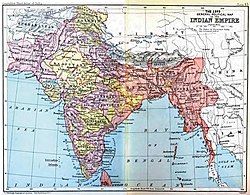3rd Mahratta War
| Third Anglo-Maratha War | |||||||
|---|---|---|---|---|---|---|---|
| Part of the Anglo-Maratha wars | |||||||
 Indian Camp Scene |
|||||||
|
|||||||
| Belligerents | |||||||
| Commanders and leaders | |||||||
|
|||||||
| Strength | |||||||
| Over 10,000 | Over 1,000 | ||||||

Imperial entities of India
|
|
| Dutch India | 1605–1825 |
|---|---|
| Danish India | 1620–1869 |
| French India | 1769–1954 |
|
|
|
| Casa da Índia | 1434–1833 |
| Portuguese East India Company | 1628–1633 |
|
|
|
| East India Company | 1612–1757 |
| Company rule in India | 1757–1858 |
| British Raj | 1858–1947 |
| British rule in Burma | 1824–1948 |
| Princely states | 1721–1949 |
| Partition of India |
1947
|
|
|
|
The Third Anglo-Maratha War (1817–1818) was the final and decisive conflict between the British East India Company (EIC) and the Maratha Empire in India. The war left the Company in control of most of India. It began with an invasion of the Maratha territory by British East India Company troops, the largest such British controlled force massed in India. The troops were led by the Governor General Hastings (no relation to Warren Hastings, the first Governor-General of Bengal) supported by a force under General Thomas Hislop. Operations began against the Pindaris, a band of Muslims and Marathas from central India.
Peshwa Baji Rao II's forces, supported by those of Mudhoji II Bhonsle of Nagpur and Malharrao Holkar III of Indore, rose against the EIC. Pressure and diplomacy convinced the fourth major Maratha leader, Daulatrao Shinde of Gwalior, to remain neutral even though he lost control of Rajasthan.
...
Wikipedia
